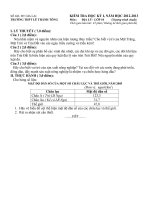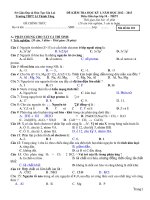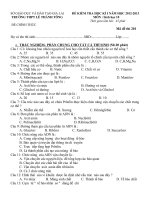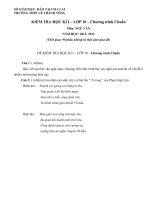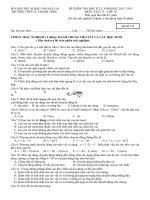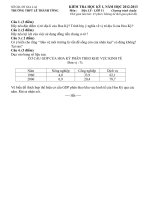fuzzy LOGIC, LE THANH PHUC
Bạn đang xem bản rút gọn của tài liệu. Xem và tải ngay bản đầy đủ của tài liệu tại đây (244.09 KB, 21 trang )
Fuzzy Logic
Le Thanh Phuc
Faculty of Automotive Engineering
University of Technical Education Ho Chi Minh City
Email:
Fuzzy Logic Concept
• The way that people think is inherently fuzzy.
• The way that we perceive the world is continually changing and
cannot always be defined in true or false statements.
• At what point did the apple cross over from being an apple to being
an apple core?
Fuzzy Logic Concept
• The definition of the apple and apple core sets are too strictly
defined when looking at the process of eating an apple.
• The area between the two sets is not clearly defined since the
object cannot belong to the set of apples and apple cores because,
by definition, an apple core is NOT an apple.
• The sets defining apples and apple cores need to be redefined as
fuzzy sets.
Fuzzy Logic Concept
• A fuzzy set allows for its members to have degrees of membership.
• If the value of 1 is assigned to objects entirely within the set and a 0 is
assigned to objects outside of the set, then any object partially in the set
will have a value between 0 and 1.
• The number assigned to the object is called its degree of membership in
the set.
• So an apple with one bite out of it may have a degree of membership of
0.9 in the set of apples. This does not mean that it has to have a degree of
membership of 0.1 in the set of apple cores though.
• However as the apple is eaten it looses its membership in the fuzzy set of
apples and gains membership in the fuzzy set of apple cores.
Defining Fuzzy Sets
• In mathematics a set, by definition, is a collection of things that
belong to some definition. Any item either belongs to that set or
does not belong to that set.
• Let us look at another example; the set of tall men. We shall say
that people taller than or equal to 6 feet are tall.
Defining Fuzzy Sets
• The fuzzy set approach to the set of tall men provides a much
better representation of the tallness of a person.
• The set, shown below, is defined by a continuously inclining
function.
Defining Fuzzy Sets
• The membership function defines the fuzzy set for the possible
values underneath of it on the horizontal axis.
• The vertical axis, on a scale of 0 to 1, provides the membership
value of the height in the fuzzy set.
• So for the two people shown above the first person has a
membership of 0.3 and so is not very tall. The second person has a
membership of 0.95 and so he is definitely tall.
• He does not, however, belong to the set of tall men in the way that
bivalent sets work; he has a high degree of membership in the fuzzy
set of tall men.
Defining Fuzzy Sets
• Membership functions for fuzzy sets can be defined in any number
of ways as long as they follow the rules of the definition of a fuzzy
set.
• The Shape of the membership function used defines the fuzzy set
and so the decision on which type to use is dependant on the
purpose.
Fuzzy Operations
• Traditional Bivalent logic uses the Boolean operators AND, OR, and
NOT to perform the intersect, union and complement operations.
• These operators work well for bivalent sets and can be essentially
defined using the following truth table:
Fuzzy Operations
• The truth table above works fine for bivalent logic but fuzzy logic
does not have a finite set of possibilities for each input; this makes
for an infinitely large truth table.
• The operators need to be defined as functions for all possible fuzzy
values, that is, all real numbers from 0 to 1 inclusive.
Fuzzy Operations
• Using these definitions they can be applied to all of the bivalent
combinations above as well as some fuzzy number combinations.
Fuzzy Decisions
• Most decisions that people make are logical decisions, they look at
the situation and make a decision based on the situation.
• The generalized form of such a decision is called a generalized
modus ponens, which is in the form:
If P, then Q
P.
Therefore, Q.
Fuzzy Decisions
• This form of logical reasoning is fairly strict, Q can only be if P.
• Fuzzy logic loosens this strictness by saying that Q can mostly be if P
is mostly or:
If P, then Q.
Mostly P.
Therefore, mostly Q.
• Where P and Q are now fuzzy numbers.
• The reasoning above requires a set of rules to be defined.
• These rules are linguistic rules to relate different fuzzy sets and numbers.
Fuzzy Decisions
• The general form of these rules are: "if x is A then y is B,"
where x and y are fuzzy numbers in the fuzzy sets A and B
respectively.
• These fuzzy sets are defined by membership functions.
• There can be any number of input and output membership
functions for the same input as well, depending on the number of
rules in the system.
• For example, a system could have membership functions that
represent slow, medium, and fast as inputs.
Fuzzy Decisions
• Let us look at a system that has two input membership functions
(A1,A2) and two output membership functions (B1, B2).
• These membership functions, shown below, define the fuzzy sets A
and B in the above general inference rule.
Fuzzy Decisions
• The input membership functions, as well as the output membership
functions, are overlapping; this means that an input value can have
membership in both membership functions, or in only one.
• If the input value has membership in a function, than any rule using
that membership function is said to 'fire' and produce a result.
• Let us then pick and input value that has membership function in
A1 and A2, 1.25, this will cause both rules to fire.
• The value 1.25 has a membership of 0.75 in A1 and a membership
of 0.25 in A2.
Fuzzy Decisions
• When all of these combinations have been made, the aggregate
output membership function (red), as well as B1 and B2 (dashed)
are shown below:
Fuzzy Decisions
• This aggregate fuzzy membership function is the result of the rule based
inference decision making process.
• To get a finite number as an output we need to go through the defuzzification
process.
• Defuzzification is a method that produces a number that best represents, and
consistently represents the fuzzy set.
• There are many ways to do this with most of them being some type of
averaging method. The most common is the centroid method, this calculates
the center of area of the fuzzy set and uses the value at which this occurs as the
defuzzified output.
• if the most common method, centroid, is used, the finite result would be 7.319.
Fuzzy Engineering
• A fuzzy logic based controller will use fuzzy membership functions and inference rules
to determine the appropriate process input.
• Designing a fuzzy controller is a more intuitive approach to controller design since it
uses a comprehendable linguistic rule base.
• A fuzzy controller can be broken down into three main processes.
• The first of these is the fuzzification, this uses defined membership functions to
process the inputs and to fuzzify them.
• These fuzzified inputs are then used in the second part, the rule-based inference
system. This system uses previously defined linguistic rules to generate a fuzzy
response.
• The fuzzy response is then defuzzified in the final process: defuzzification. This process
will provide a real number as an output.
MATLAB FUZZY
References
• />


